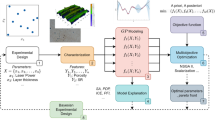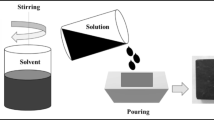Abstract
An additive manufacturing process of selective laser sintering (SLS) builds components of complex 3D shapes directly from metal powder. Past studies reveal that the properties of an SLS-fabricated prototype such as porosity, surface roughness, waviness, compressive strength, tensile strength, wear strength, and dimensional accuracy depend on the parameter settings of the SLS setup and can be improved by appropriate adjustment. In this context, the computational intelligence (CI) approach of multi-gene genetic programming (MGGP) can be used to formulate the model for understanding the process behavior. MGGP develops the model structure and its coefficients automatically. Despite being widely applied, MGGP generates models that may not give satisfactory performance on test data. The underlying reason is the inappropriate formulation procedure of the multi-gene model and the difficulty in model selection. Therefore, the present work proposes a new CI approach (ensemble-based MGGP (EN-MGGP)) that makes use of statistical and classification strategies for improving its generalization. The EN-MGGP approach is applied to the open porosity data obtained from the experiments conducted on an SLS machine, and its performance is compared to that of the standardized MGGP. The proposed EN-MGGP model outperforms the standardized model and is proven to capture the dynamics of the SLS process by unveiling dominant input process parameters and the hidden non-linear relationships.
Similar content being viewed by others
References
Deckard CR, McClure P (1988) Selective laser sintering
Garg A, Tai K, Savalani M (2014) State-of-the-art in empirical modelling of rapid prototyping processes. Rapid Prototyp J 20(2):164–178
Raghunath N, Pandey PM (2007) Improving accuracy through shrinkage modelling by using Taguchi method in selective laser sintering. Int J Mach Tools Manuf 47(6):985–995
Tontowi AE, Childs T (2001) Density prediction of crystalline polymer sintered components at various powder bed temperatures. Rapid Prototyp J 7(3):180–184
Nelson JC et al (1993) Model of the selective laser sintering of bisphenol-A polycarbonate. Ind Eng Chem Res 32(10):2305–2317
Cervera GBM, Lombera G (1999) Numerical prediction of temperature and density distributions in selective laser sintering processes. Rapid Prototyp J 5(1):21–26
Singh A, Prakash RS (2010) DOE based three-dimensional finite element analysis for predicting density of a laser-sintered component. Rapid Prototyp J 16(6):460–467
Shen X et al (2004) Density prediction of selective laser sintering components based on artificial neural network. In: Advances in neural networks-ISNN 2004, Springer, p 832–840
Li X-f, Dong J-h, Zhang Y-z (2009) Modeling and applying of RBF neural network based on fuzzy clustering and pseudo-inverse method. In: Information engineering and computer science, 2009. ICIECS 2009. International Conference on. IEEE
Cong-Zhong C et al (2009) Density prediction of selective laser sintering components based on support vector regression. Acta Phys Sin 58(6):S8–S14
Chatterjee A et al (2003) An experimental design approach to selective laser sintering of low carbon steel. J Mater Process Technol 136(1):151–157
Liao H-T, Shie J-R (2007) Optimization on selective laser sintering of metallic powder via design of experiments method. Rapid Prototyp J 13(3):156–162
Kruth JP, Kumar S (2005) Statistical analysis of experimental parameters in selective laser sintering. Adv Eng Mater 7(8):750–755
Beal V et al (2009) Statistical evaluation of laser energy density effect on mechanical properties of polyamide components manufactured by selective laser sintering. J Appl Polym Sci 113(5):2910–2919
Gandomi AH, Alavi AH (2011) Multi-stage genetic programming: a new strategy to nonlinear system modeling. Inf Sci 181(23):5227–5239
Gandomi AH et al (2010) Genetic programming and orthogonal least squares: a hybrid approach to modeling the compressive strength of CFRP-confined concrete cylinders. J Mech Mater Struct 5(5):735–753
Garg A, Rachmawati L, Tai K (2013) Classification-driven model selection approach of genetic programming in modelling of turning process. Int J Adv Manuf Technol 69(5–8):1137–1151
Garg A, Tai K, Savalani M (2014) Formulation of bead width model of an SLM prototype using modified multi-gene genetic programming approach. Int J Adv Manuf Technol 73(1–14):375–388
Savalani MM et al (2012) The effects and interactions of fabrication parameters on the properties of selective laser sintered hydroxyapatite polyamide composite biomaterials. Rapid Prototyp J 18(1):16–27
Bonfield W, Wang M, Tanner KE (1998) Interfaces in analogue biomaterials. Acta Mater 46:2509–2518
Yang H-J, Hwang P-J, Lee S-H (2002) A study on shrinkage compensation of the SLS process by using the Taguchi method. Int J Mach Tools Manuf 42:1203–1212
Koza JR (1994) Genetic programming II: automatic discovery of reusable programs
Garg A, Tai K (2013) Genetic programming for modeling vibratory finishing process: role of experimental designs and fitness functions. In: Swarm, evolutionary, and memetic computing, Springer International Publishing, p 23–31
Garg A et al (2014) A computational intelligence-based genetic programming approach for the simulation of soil water retention curves. Transp Porous Media 103(3):497–513
Garg A, Tai K (2014) An ensemble approach of machine learning in evaluation of mechanical property of the rapid prototyping fabricated prototype. In: Applied mechanics and materials
Garg A, Tai K (2014) Stepwise approach for the evolution of generalized genetic programming model in prediction of surface finish of the turning process. Adv Eng Softw 78:16–27
Garg A, Tai K, Gupta A (2014) A modified multi-gene genetic programming approach for modelling true stress of dynamic strain aging regime of austenitic stainless steel 304. Meccanica 49(5):1193–1209
Garg A et al (2014) Mathematical modelling of burr height of the drilling process using a statistical-based multi-gene genetic programming approach. Int J Adv Manuf Technol 73:113–126
Garg A et al (2014) Combined CI-MD approach in formulation of engineering moduli of single layer graphene sheet. Simul Model Pract Theory 48:93–111
Vijayaraghavan V et al (2014) Process characterisation of 3D-printed FDM components using improved evolutionary computational approach. Int J Adv Manuf Technol :1–13. doi: 10.1007/s00170-014-6679-5
Vijayaraghavan V et al (2014) An integrated computational approach for determining the elastic properties of boron nitride nanotubes. Int J Mech Mater Des :1–14. doi: 10.1007/s10999-014-9262-1
Hinchliffe M et al (1996) Modelling chemical process systems using a multi-gene genetic programming algorithm
Searson DP, Leahy DE, Willis MJ (2010) GPTIPS: an open source genetic programming toolbox for multigene symbolic regression. In: Proceedings of the International MultiConference of Engineers and Computer Scientists, Citeseer, p 77–80
Lee CKM, Lam JSL (2012) Managing reverse logistics to enhance sustainability of industrial marketing. Ind Mark Manag 41(4):589–598. doi:10.1016/j.indmarman.2012.04.006
Yang CB, Deng CS, Chiang HL (2012) Combining the taguchi method with artificial neural network to construct a prediction model of a CO 2 laser cutting experiment. Int J Adv Manuf Technol 59(9–12):1103–1111
Zhang Y, Yang J, Jiang H (2012) Machine tool thermal error modeling and prediction by grey neural network. Int J Adv Manuf Technol 59(9–12):1065–1072
Zinati RF, Razfar MR (2012) Constrained optimum surface roughness prediction in turning of X20Cr13 by coupling novel modified harmony search-based neural network and modified harmony search algorithm. Int J Adv Manuf Technol 58(1–4):93–107
Lam JSL, Gu Y (2013) Port hinterland intermodal container flow optimisation with green concerns: a literature review and research agenda. International Journal of Shipping Transport and Logistics 5(3):257–281
Author information
Authors and Affiliations
Corresponding author
Rights and permissions
About this article
Cite this article
Garg, A., Lam, J.S.L. & Savalani, M.M. A new computational intelligence approach in formulation of functional relationship of open porosity of the additive manufacturing process. Int J Adv Manuf Technol 80, 555–565 (2015). https://doi.org/10.1007/s00170-015-6989-2
Received:
Accepted:
Published:
Issue Date:
DOI: https://doi.org/10.1007/s00170-015-6989-2




